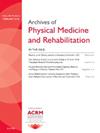平衡运动和快走对缓解轻度至中度帕金森病患者的非运动症状和运动症状的效果:一项为期 6 个月的随机临床试验。
IF 3.6
2区 医学
Q1 REHABILITATION
Archives of physical medicine and rehabilitation
Pub Date : 2024-10-01
DOI:10.1016/j.apmr.2024.05.031
引用次数: 0
摘要
目的调查帕金森病(PD)患者在训练后和6个月随访期间,平衡锻炼和快走对非运动症状和运动症状、平衡和步态功能、行走能力以及平衡信心的影响:设计:双臂、评估者盲法随机对照试验:参与者:99 名符合条件的帕金森病患者:99 名符合条件的轻度至中度帕金森病患者:参与者被随机分配到平衡和快走组(B&B,49 人)或积极对照组(CON,50 人)。B&B组在理疗师的监督下进行10次90分钟的平衡练习和快走,为期6个月(第1-6周:每周一次,第7-26周:每月一次),而CON组则以相同的剂量(180分钟/周)进行全身柔韧性和上肢力量练习。在干预期间,两组患者均在无人监督的情况下进行家庭锻炼,每周 2-3 次,并在随访时继续进行:主要结果和测量方法:主要结果为运动障碍协会统一帕金森病评分量表非运动性(MDS-UPDRS-I)和运动性(MDS-UPRDS-III)评分。次要结果为迷你平衡评估系统测试(Mini-BEST)得分、舒适步态速度(CGS)、六分钟步行距离(6MWD)、双任务定时起立行走(DTUG)时间和特定活动平衡信心量表(ABC)得分:83人完成了为期6个月的干预,未出现严重不良反应。6 个月时,MDS-UPDRS 非运动评分的组间平均差异(95% CI)为 1.50(0.19-2.81),12 个月时为 1.09(-0.66-2.85)。6 个月时,MDS-UPDRS 运动评分的组间平均差异(95% CI)为 3.75(0.69-6.80),12 个月时为 4.57(1.05-8.01)。在 6 个月和 12 个月时,B&B 组在 Mini-BEST 评分、CGS、6MWD 和 DTUG 时间方面均有显著的组间改善:这种平衡与快走相结合的锻炼计划可减轻轻度至中度帕金森病患者的非运动症状和运动症状,提高训练后的行走能力、平衡能力和步态功能,并在6个月的随访中对除非运动外的所有结果产生积极的延续性影响。本文章由计算机程序翻译,如有差异,请以英文原文为准。
Effectiveness of Balance Exercise and Brisk Walking on Alleviating Nonmotor and Motor Symptoms in People With Mild-to-Moderate Parkinson Disease: A Randomized Clinical Trial With 6-Month Follow-up
Objective
To investigate the effects of balance exercise and brisk walking on nonmotor and motor symptoms, balance and gait functions, walking capacity, and balance confidence in Parkinson disease (PD) at posttraining and 6-month follow-up.
Design
Two-arm, assessor-blinded randomized controlled trial
Setting
University research laboratory and the community
Participants
Ninety-nine eligible individuals with mild-to-moderate PD
Interventions
Participants were randomized to balance and brisk walking group (B&B, n=49) or active control group (n=50). B&B received ten 90-minute sessions of balance exercises and brisk walking supervised by physical therapists for 6 months (week 1-6: weekly, week 7-26: monthly), whereas control practiced whole-body flexibility and upper limb strength exercise at same dosage (180 min/wk). Both groups performed unsupervised home exercises 2-3 times/wk during intervention and continued at follow-up.
Main Outcome Measures
Primary outcomes were Movement Disorder Society Unified Parkinson Disease Rating Scale nonmotor (MDS-UPDRS-I) and motor (MDS-UPRDS-III) scores. Secondary outcomes were mini-Balance Evaluation Systems Test (mini-BEST) score, comfortable gait speed (CGS), 6-minute walk test (6MWT), dual-task timed-Up-and-Go (DTUG) time, and Activities-Specific Balance Confidence Scale score.
Results
Eighty-three individuals completed the 6-month intervention with no severe adverse effects. The mean between-group (95% CI) difference for the MDS-UPDRS nonmotor score was 1.50 (0.19-2.81) at 6 months and 1.09 (−0.66 to 2.85) at 12 months. The mean between-group (95% CI) difference for the MDS-UPDRS motor score was 3.75 (0.69-6.80) at 6 months and 4.57 (1.05-8.01) at 12 months. At 6 and 12 months, there were significant between-group improvements of the B&B group in mini-BEST score, CGS, 6MWT, and DTUG time.
Conclusions
This combined balance and brisk walking exercise program alleviates nonmotor and motor symptoms and improves walking capacity, balance, and gait functions posttraining, with positive carryover effects for all except nonmotor outcomes, at 6-month follow-up in mild-to-moderate PD.
求助全文
通过发布文献求助,成功后即可免费获取论文全文。
去求助
来源期刊
CiteScore
6.20
自引率
4.70%
发文量
495
审稿时长
38 days
期刊介绍:
The Archives of Physical Medicine and Rehabilitation publishes original, peer-reviewed research and clinical reports on important trends and developments in physical medicine and rehabilitation and related fields. This international journal brings researchers and clinicians authoritative information on the therapeutic utilization of physical, behavioral and pharmaceutical agents in providing comprehensive care for individuals with chronic illness and disabilities.
Archives began publication in 1920, publishes monthly, and is the official journal of the American Congress of Rehabilitation Medicine. Its papers are cited more often than any other rehabilitation journal.

 求助内容:
求助内容: 应助结果提醒方式:
应助结果提醒方式:


